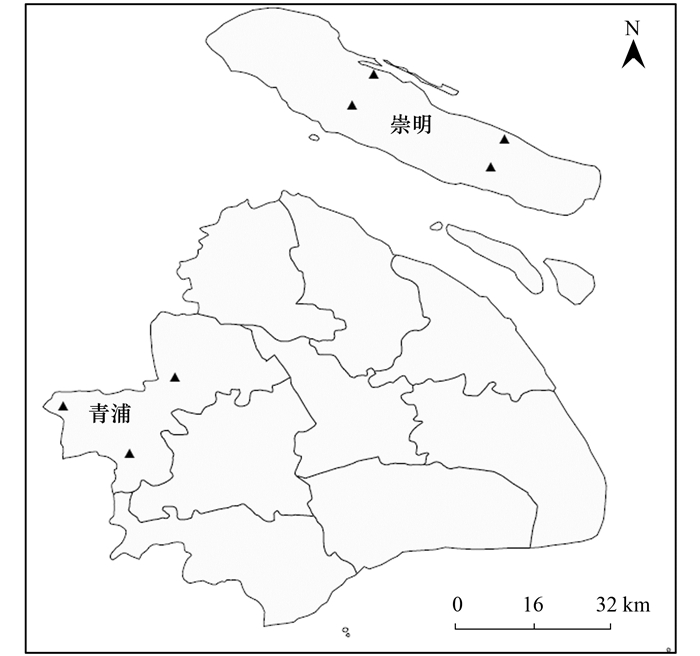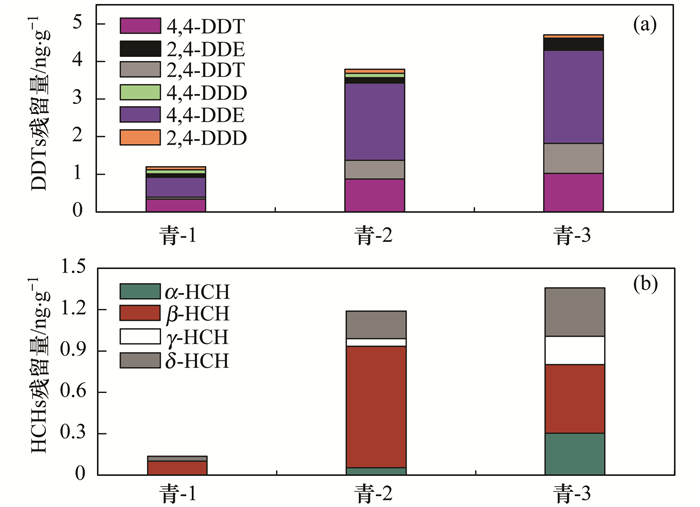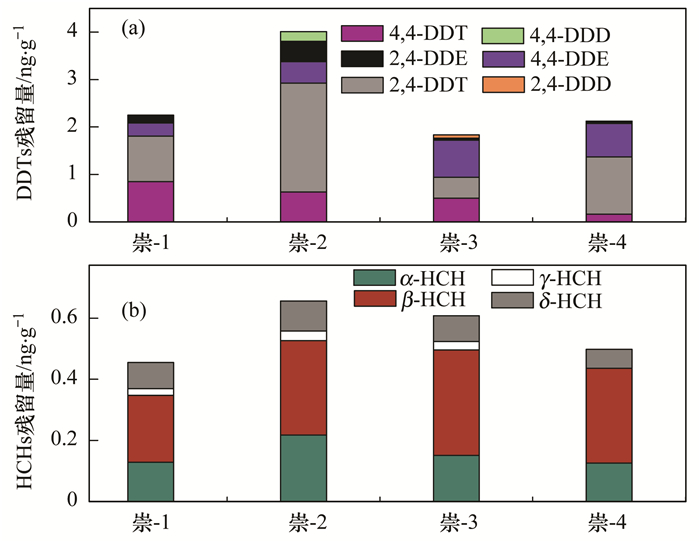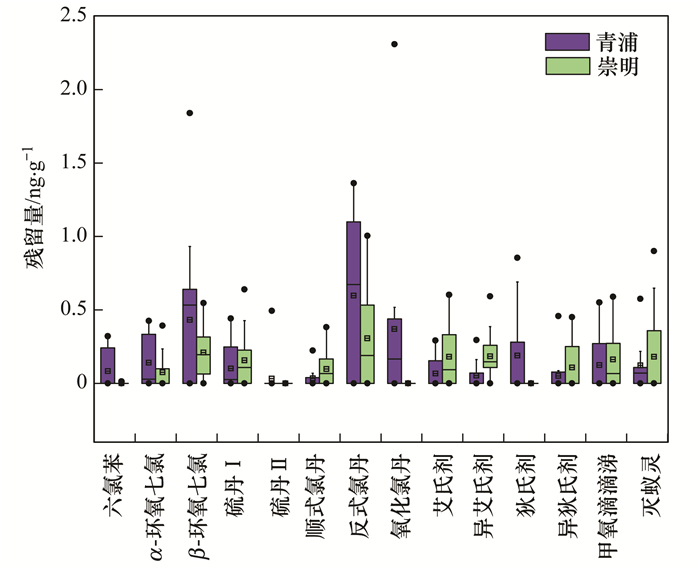作为一种高效的杀虫剂和除草剂, 有机氯农药(organochlorine pesticides, OCPs)曾在世界各地被广泛使用.其理化性质稳定, 具有高毒性、高持久性和高累积性[1, 2], 是一种典型的持久性有机污染物(persistent organic pollutants, POPs).由于有机氯农药容易在生物和人体内积累, 造成各种急慢性毒性、内分泌干扰效应、三致效应(致癌、致畸、致突变)等危害[3, 4], 因此部分有机氯农药已被列入《POPs公约》中的受控POPs名单, 并在世界各地逐渐禁用[5~7].中国作为农药的生产和使用大国, 曾大量使用滴滴涕(DDTs)、六六六(HCHs)、六氯苯(HCB)、艾氏剂(Aldrin)、狄氏剂(Dieldrin)、七氯(Heptachlor)等有机氯农药.据统计, 到1983年为止我国DDTs和HCHs的累计生产量分别达到40万t和490万t, 占世界总产量的20%和33%[8, 9].尽管中国自1983年起宣布停止DDTs和HCHs的生产, 然而在水体、土壤等各个环境介质中仍有一定的检出[10, 11].
稻米是支撑世界上近60%人口的粮食[12], 稻米中的有机氯农药主要通过膳食进入人体从而影响人类健康[13].目前国内外研究多集中于稻米中重金属的污染状况及健康风险评价[14~17], 而针对有机氯农药的研究相对较少. Mumtaz等[18]检测了巴基斯坦旁遮普邦稻米中有机氯农药的残留水平并对其进行健康风险评价, 发现DDTs和HCHs是该区域稻米中最主要的有机氯农药, 且食用当地稻米有一定的致癌风险. Chen等[19]研究了江苏省7个城市中的稻米OCPs残留, 检出的DDTs、HCHs残留量分别为0~0.053 mg·kg-1、0~0.039 mg·kg-1, 其他OCPs没有检出.
水稻是上海市的主要粮食作物, 青浦和崇明区是其重要的水稻种植基地.青浦区位于上海西南部, 据2016年统计, 青浦区水稻播种面积为78 km2.崇明岛位于长江入海口, 是世界上最大的河口冲积岛, 全岛地势平坦, 土地肥沃, 是上海市农产品重要的生产基地[20].
本文以上海市青浦、崇明区的稻米为研究对象, 分析了24种有机氯农药的残留水平及组成特征, 并对研究区稻米的食用进行初步的健康风险评价, 以期为有机氯农药的控制管理提供一定理论依据.
1 材料与方法 1.1 样品的采集本研究于2015年11月在青浦区淀山湖附近设置3个采样单元共15个采样点, 于2016年10月在崇明西北部和中东部设置4个采样单元共20个采样点(图 1).实施采样时, 每个采样单元在同一块稻田内, 大小约60 m×150 m, 每个采样单元内设5个采样点, 每个采样点范围约20 m×30 m, 包括东、西、南、北、中这5个分点, 将5个分点所采集的稻谷混合作为一个样点的样品, 每个采样点采集约500 g稻谷样品.样品经干燥、脱壳后用球磨仪研磨至粉状, 贮于玻璃样品瓶中备测.

|
图 1 采样区域示意 Fig. 1 Regions for sampling |
称取5 g稻米样品于玻璃离心管中, 加入两种多氯联苯同系物替代标PCB53和PCB200.加入正己烷和丙酮混合液(8:2), 经涡旋振荡、超声提取、离心, 此过程重复3次.将提取液旋蒸浓缩至约1 mL, 用正己烷转移并氮吹至约2 mL, 待进一步净化.
将提取液施于凝胶渗透色谱柱, 用正己烷和二氯甲烷混合液(1:1)淋洗, 收集的淋洗液经旋蒸浓缩并氮吹至约2 mL.后将样品转移至Florisil柱以进一步净化. Florisil柱顶端加入MgSO4, 经丙酮、正己烷活化后, 加入样品溶液, 用正己烷和丙酮混合液(9:1)进行洗脱, 将洗脱液氮吹至约1 mL转移至GC小瓶, 再氮吹至近干, 加入内标PCNB(五氯硝基苯)和PCB189, 定容至200 μL, 待上机分析.
1.3 仪器分析条件采用Agilent 7890A型气相色谱与电子捕获检测器(GC-ECD)对样品进行定量分析.色谱柱为Agilent DB-5(30 m×250 μm×0.25 μm); 载气为高纯氮气, 流速1.1 mL·min-1; 进样量为1 μL, 无分流; 进样口温度为250℃, 检测器温度为325℃; 升温程序:初始温度80℃保持2 min, 以10 ℃·min-1的速率升至195℃, 后以3 ℃·min-1的速率升至230℃, 再以10 ℃·min-1的速率升至310℃(保持5 min).
1.4 质量控制采用方法空白、空白加标、样品平行样和标准工作曲线等手段来进行分析质量控制.每做5个样品同时做两个空白样品, 每个采样点样品做3个平行样.采用内标法定量, 以4, 4-DDE的保留时间为界, 在此之前出峰采用内标PCNB, 之后采用内标PCB189.各标准工作曲线的线性相关系数都在0.999以上, 各目标物的平均回收率为68.2%~121%.替代标PCB53回收率为70%~105%, PCB200回收率为72%~96%.
1.5 风险评价采用USEPA推荐的健康风险评价模型, 对上海地区稻米中有机氯农药进行健康风险评价[21].食用含有OCPs的稻米引起的健康风险包括致癌风险和非致癌风险.用该模型计算有机氯农药摄食途经下的长期日暴露量[chronic daily intake, CDI, 单位:mg·(kg·d)-1], 计算公式为:

|
(1) |
式中, C为稻米中污染物的含量(mg·kg-1); IR为日均摄入量(kg·d-1), 参考2008年浙江省城乡居民膳食结构调查报告, 城乡居民每人每日稻米平均摄入量为0.314 kg·d-1; EF为暴露频率(d·a-1), 取值365; ED为暴露持续时间(a), 取值70; BW为平均人体质量(kg), 取值60; AT为终生平均作用时间(d), 取值25 550.
致癌风险用风险值(Risk)表示, 计算公式如下:

|
(2) |
式中, RI为风险指数; SF是致癌斜率因子(kg·d·mg-1).
非致癌风险用危害指数(HI)表示, 计算公式如下:

|
(3) |
式中, RfDi为致癌污染物i的参考剂量[mg·(kg·d)-1].各污染物质的致癌斜率因子、参考剂量来自USEPA综合风险信息系统[22](见表 1).
|
|
表 1 OCPs的致癌斜率因子和参考剂量值 Table 1 Data for SF and RfDi of the OCPs |
2 结果与讨论 2.1 稻米中OCPs的残留状况
青浦和崇明地区稻米样品中24种有机氯农药的残留水平见表 2.总体而言, 青浦稻米样品有机氯农药的总含量范围为0.17~12.72 ng·g-1, 平均含量是6.53 ng·g-1. DDTs和HCHs在所有稻米样品中均有检出, 是最主要的残留组分, 含量范围分别为0.11~5.68 ng·g-1和0.06~2.44 ng·g-1.除此之外, 其他OCPs在部分稻米样品中也有检出, 占OCPs总残留量的0~53.8%, 其中氯丹、环氧七氯的残留量和检出率相对较高, 平均含量分别为0.63 ng·g-1、0.57 ng·g-1, 检出率均为73.3%.
|
|
表 2 青浦和崇明稻米中OCPs的残留量1) Table 2 Residues of OCPs in rice samples from Qingpu and Chongming |
崇明地区稻米中除氧化氯丹、狄氏剂未有检出外, 其他OCPs均有一定的检出, 总OCPs含量范围为0.31~10.76 ng·g-1, 平均含量是4.70 ng·g-1.其中DDTs和HCHs是主要残留组分, 含量范围分别为0.05~6.61 ng·g-1和0.11~0.83 ng·g-1, 占OCPs总残留量的15.4~69.1%和4.1~28.5%.氯丹、艾氏剂、异艾氏剂、环氧七氯、甲氧滴滴涕等也在崇明稻米中有所残留, 其中氯丹、环氧七氯的残留量和检出率比其他组分高, 残留范围分别为N.D.~1.10 ng·g-1和N.D.~0.81 ng·g-1, 检出率分别为95%和90%.
本研究区中DDTs、HCHs、氯丹、艾氏剂、狄氏剂、异狄氏剂、灭蚁灵的残留量均远低于食品安全国家标准(GB 2763-2014)[23]中对应稻米的再残留限值, 表明上海市稻米中OCPs的残留处于安全水平.
2.2 稻米中OCPs的组成特征 2.2.1 青浦地区稻米中DDTs和HCHs的组成特征青浦地区DDTs和HCHs各组分组成特征见图 2.青浦稻米中6种DDTs同系物均有不同程度检出, 其中以4, 4-DDE残留最高, 检出率为100%, 残留范围为0.05~3.10 ng·g-1, 占ΣDDTs的31.7%~67.2%.其次为4, 4-DDT和2, 4-DDT, 含量范围分别为N. D.~1.43 ng·g-1、N. D.~1.36 ng·g-1, 占ΣDDTs的0~42.7%和0~31.2%. DDTs各组分残留量从高到低依次为4, 4-DDE>4, 4-DDT>2, 4-DDT>2, 4-DDE>2, 4-DDD>4, 4-DDD.从图 2(a)可以看出, 青浦不同采样单元稻米中DDTs的组成特征有一定规律, 而残留量有所差异, 其总体残留水平为第三采样单元>第二采样单元>第一采样单元.有研究表明, 4, 4-DDT/(4, 4-DDE+4, 4-DDD)的比值可以用来判断有无新DDT的输入, 若比值大于1, 表明有新DDT源的释放, 反之则表明土壤中的DDT来源于历史上的使用[24].在本研究区域该比值在0~0.67之间, 表明稻米中DDTs均来源于早期农药施用的残留.另外, 2, 4-DDT/4, 4-DDT可用于区分工业DDTs和三氯杀螨醇的来源[24].由于三氯杀螨醇中2, 4-DDT含量较高, 2, 4-DDT/4, 4-DDT在1.3~9.3或是更高表明有三氯杀螨醇的使用, 而工业DDTs中该比值则在0.2~0.3之间.本研究2, 4-DDT/4, 4-DDT在0~2.03之间, 有14.3%的点位超过1.3, 表明研究区域内稻米DDT大部分源于工业DDTs的使用, 而局部区域三氯杀螨醇的使用或许是DDT的主要来源.

|
图 2 青浦地区稻米中DDTs及HCHs组份组成特征 Fig. 2 Compositions of DDTs and HCHs in rices from Qingpu |
青浦稻米中HCHs主要的4种异构体α-、β-、γ-、δ-HCH均有检出, 与样品中DDTs相比, HCHs的残留水平稍低, 各异构体的平均含量从高至低依次为β-HCH(0.49 ng·g-1)>δ-HCH(0.20 ng·g-1)>α-HCH(0.12 ng·g-1)>γ-HCH(0.09 ng·g-1), 它们对ΣHCHs的平均贡献率分别为59.49%、25.13%、8.47%、6.91%.不同采样单元稻米中的HCHs总体残留水平与DDTs基本一致, 由高到低依次为第三采样单元>第二采样单元>第一采样单元.究其原因, 这种采样单元之间的差异可能由于周边环境不同所致. α-HCH/γ-HCH的比值可以用于判断HCHs的来源, 若α-HCH/γ-HCH在4~7之间, 表明该地区HCHs主要来源于历史残留的工业HCHs; 若α-HCH/γ-HCH小于1, 则表明该地区近期有林丹的释放[25].本研究中α-HCH/γ-HCH在0.36~34.03, 其中有75%的点位比值小于1, 说明稻米中大部分HCHs可能来源于近期林丹的使用.
2.2.2 崇明地区稻米中DDTs和HCHs的组成特征崇明稻米中DDTs的6种同系物平均残留量从高到低依次为2, 4-DDT(1.23 ng·g-1)>4, 4-DDE(0.56 ng·g-1)>4, 4-DDT(0.54 ng·g-1)>2, 4-DDE(0.17 ng·g-1)>4, 4-DDD(0.05 ng·g-1)>2, 4-DDD(0.02 ng·g-1).由图 3(a)可知, 崇明地区不同采样单元稻米中DDT组成特征有所差异, 其中一、二采样单元稻米中2, 4-DDT和4, 4-DDT是其主要残留类型, 分别占该地块DDTs的37.9%和36.6%;而三、四采样单元稻米中以4, 4-DDE和2, 4-DDT残留量较高, 分别占ΣDDTs的50.7%和28.8%.由于崇明是长江冲积形成的岛屿, 岛上不同方位的土壤成陆时间不一, 理化性质存在差异.本研究所涉及的稻田, 位于崇明西北部长江北支边的一、二采样单元, 是近年泥沙冲积形成的新土地, 位于崇明中东部的三、四采样单元是冲积形成已久的旧土地.崇明地区稻米中4, 4-DDT/(4, 4-DDE+4, 4-DDD)的比值在0~7.24, 其中新生土地的稻米样品该比值皆小于1, 而旧土地的稻米样品中有62.5%超过1, 表明新土地稻米中DDTs主要来源于早期农药的施用, 其最初来源可能为长江从上中游沿岸携带而来, 而旧土地多半地区可能存在新的DDTs输入.对于2, 4-DDT/4, 4-DDT的比值, 新旧土地各有44.4%、62.5%的点位超过1.3, 表明研究区域内或许存在三氯杀螨醇的使用.

|
图 3 崇明地区稻米中DDTs及HCHs组分组成特征 Fig. 3 Compositions of DDTs and HCHs in rices from Chongming |
崇明地区HCHs残留水平稍低于DDTs, 平均残留量由高到低依次为β-HCH(0.30 ng·g-1)>α-HCH(0.16 ng·g-1)>δ-HCH(0.08 ng·g-1)>γ-HCH(0.02 ng·g-1), 检出率分别为100%、90%、95%、35%.本研究中α-HCH/γ-HCH比值均大于1, 说明崇明地区HCHs主要来源于历史残留的工业HCHs, 近期没有林丹使用的迹象.
2.2.3 稻米中其他OCPs的组成特征青浦和崇明地区稻米中其他OCPs的残留水平见图 4, 除顺式氯丹、艾氏剂、灭蚁灵等少数OCPs外, 青浦地区稻米中OCPs残留量整体高于崇明.青浦地区稻米中反式氯丹、β-环氧七氯、氧化氯丹的残留量和检出率较高, 平均含量分别为0.60、0.49、0.43 ng·g-1, 检出率分别为60%、53.3%、53.3%.反式氯丹、艾氏剂、异艾氏剂、β-环氧七氯、甲氧滴滴涕等在崇明稻米中有所残留, 其中反式氯丹和异艾氏剂的残留量相对较高, 残留范围分别为N.D.~1.00 ng·g-1和N.D.~0.59 ng·g-1, 检出率为65%和85%.与国内外相比, 本研究中环氧七氯、氯丹、硫丹、六氯苯的残留量均低于中国环鄱阳湖[26]、江西[27]、巴基斯坦[18]、泰国[28]稻米中相应物质的含量.其中六氯苯在我国并未用于农业生产, 而是作为五氯酚和五氯酚钠的中间体, 以及防治血吸虫病的有效杀虫剂[29].六氯苯具有较高的蒸气压和较强的挥发性, 因此环境中的六氯苯更容易在大气中进行远距离迁移[26, 30].本研究稻米中HCB结果较低的原因可能包括两个方面:一是当地环境中HCB的背景含量较低, 二是由于HCB本身的理化性质和水稻的生理生化性质, 导致其不易在稻米中积累.

|
图 4 稻米中其他OCPs的残留状况 Fig. 4 Residues of other OCPs in rices from Qingpu and Chongming |
目前有关艾氏剂、异艾氏剂、狄氏剂、异狄氏剂的残留水平研究较少.虽然艾氏剂和狄氏剂在中国未曾用于大规模生产, 仅在实验室阶段有少量的合成和研究, 然而研究表明, 艾氏剂和狄氏剂在中国各个环境介质如大气[31]、水体[32]、沉积物[33~35]、土壤[36~39]中有所检出, 甚至在作物[40, 41]、人体脐带血[42, 43]中也有所检出.比较本研究中测得艾氏剂和狄氏剂含量发现, 上海市艾氏剂和狄氏剂的污染水平处于中国OCPs的中低浓度水平.中国艾氏剂和狄氏剂的检出原因主要有两点, 一是由于某些低纬度发展中国家仍在使用艾氏剂和狄氏剂, 使其通过长距离的大气传输及全球蒸馏效应迁移并沉降到中国[37, 44], 另一方面科学研究的小规模使用、某些地区可能存在的违禁使用也会造成其检出[33, 38, 42].总体而言, 本研究区稻米中的上述OCPs处于较低的污染水平.
2.3 稻米中OCPs的健康风险评估稻米是上海市居民的主要粮食作物之一, 为考察研究区稻米的质量安全, 以摄食为人体暴露途径, 评价其对人体产生的致癌和非致癌风险, 评价结果见表 3.
|
|
表 3 上海市稻米中OCPs的致癌风险指数(RI)和非致癌危害指数(HI) Table 3 RI and HI of OCPs in rice samples from Shanghai |
参考国际辐射防护委员会、美国环保署等提供的与致癌风险相关的各项参数, 致癌风险值小于10-6~10-4被认为是可接受水平[21, 45, 46].在本研究中, 青浦、崇明稻米中8种OCPs的总致癌风险指数ΣRI分别为6.83×10-5和7.7×10-5, 尚处于可接受水平.对于单污染物的致癌风险, 本研究区域所有OCPs均处于可接受水平.总体而言, 本研究区域稻米中OCPs的致癌健康风险较低, 对食用人群身体健康基本不造成致癌风险.
所检出的有机氯农药各组分的非致癌危害指数HI值范围分别为3.49×10-5~0.1, 青浦和崇明稻米中8种OCPs的非致癌危害指数ΣHI分别为0.14和0.19, 远低于美国环保署标准(HI<1), 表明长期食用该研究区稻米基本不会因本研究所涉及的污染物对人体健康产生非致癌风险.
3 结论(1) 上海市稻米中传统OCPs仍普遍存在, 且均以DDTs和HCHs为主要残留物.青浦和崇明区稻米中24种OCPs的含量范围分别为0.17~12.72 ng·g-1和0.31~10.76 ng·g-1, 远低于食品安全国家标准中的再残留限值, 处于安全水平.
(2) 研究区稻米中的DDTs和HCHs各同系物均有不同程度检出, 青浦区以4, 4-DDE和β-HCH为主, 崇明区以2, 4-DDT和β-HCH为主.青浦区稻米中的DDTs主要来自早期农药施用, 局部地区可能存在三氯杀螨醇的使用, HCHs很可能主要来源于林丹的近期使用; 崇明区新生土地稻米中DDTs主要来源于早期农药的施用, 旧土地则多半有新的工业DDTs输入, 崇明地区无论新旧土地近期均可能有三氯杀螨醇的使用, 而HCHs主要还是来源于历史残留.
(3) 青浦和崇明区稻米中8种OCPs的总致癌风险指数分别为6.83×10-5、7.7×10-5, 非致癌危害指数分别为0.14、0.19, 没有超出可接受水平, 表明长期食用本研究区稻米基本不会因本研究的OCPs对人体健康产生危害.
| [1] | El-Shahawi M S, Hamza A, Bashammakh A S, et al. An overview on the accumulation, distribution, transformations, toxicity and analytical methods for the monitoring of persistent organic pollutants[J]. Talanta, 2010, 80(5): 1587-1597. DOI:10.1016/j.talanta.2009.09.055 |
| [2] | Jones K C, de Voogt P. Persistent organic pollutants (POPs):state of the science[J]. Environmental Pollution, 1999, 100(1-3): 209-221. DOI:10.1016/S0269-7491(99)00098-6 |
| [3] | Rissato S R, Galhiane M S, Ximenes V F, et al. Organochlorine pesticides and polychlorinated biphenyls in soil and water samples in the Northeastern part of São Paulo State, Brazil[J]. Chemosphere, 2006, 65(11): 1949-1958. DOI:10.1016/j.chemosphere.2006.07.011 |
| [4] | Mahugija J A M, Henkelmann B, Schramm K W. Levels, compositions and distributions of organochlorine pesticide residues in soil 5-14 years after clean-up of former storage sites in Tanzania[J]. Chemosphere, 2014, 117: 330-337. DOI:10.1016/j.chemosphere.2014.07.052 |
| [5] | Gao J, Zhou H F, Pan G Q, et al. Factors influencing the persistence of organochlorine pesticides in surface soil from the region around the Hongze Lake, China[J]. Science of the Total Environment, 2013, 443: 7-13. DOI:10.1016/j.scitotenv.2012.10.086 |
| [6] | Ahad K, Mohammad A, Khan H, et al. Monitoring results for organochlorine pesticides in soil and water from selected obsolete pesticide stores in Pakistan[J]. Environmental Monitoring and Assessment, 2010, 166(1-4): 191-199. DOI:10.1007/s10661-009-0995-5 |
| [7] | Stockholm Convention on persistent organic pollutants (POPs), All POPs listed in the Stockholm Convention[EB/OL]. http://www.pops.int/TheConvention/ThePOPs/AllPOPs/tabid/2509/Default.aspx. |
| [8] |
华小梅, 单正军. 我国农药的生产, 使用状况及其污染环境因子分析[J]. 环境科学进展, 1996, 4(2): 33-45. Hua X M, Shan Z J. The producticn and application of pestidices and factor analysis of their pollution in environment in China[J]. Advances in Environmental Science, 1996, 4(2): 33-45. |
| [9] |
迭庆杞, 聂志强, 黄启飞, 等. 珠江三角洲土壤中有机氯农药的分布特征[J]. 农业环境科学学报, 2014, 33(2): 298-304. Die Q Q, Nie Z Q, Huang Q F, et al. Organochlorine pesticides (OCPs) in soils of Pearl River Delta, China[J]. Journal of Agro-Environment Science, 2014, 33(2): 298-304. DOI:10.11654/jaes.2014.02.014 |
| [10] | Mishra K, Sharma R C, Kumar S. Contamination levels and spatial distribution of organochlorine pesticides in soils from India[J]. Ecotoxicology and Environmental Safety, 2012, 76: 215-225. DOI:10.1016/j.ecoenv.2011.09.014 |
| [11] | Qu C K, Qi S H, Yang D, et al. Risk assessment and influence factors of organochlorine pesticides (OCPs) in agricultural soils of the hill region:a case study from Ningde, southeast China[J]. Journal of Geochemical Exploration, 2015, 149: 43-51. DOI:10.1016/j.gexplo.2014.11.002 |
| [12] | Nguyen T D, Han E M, Seo M S, et al. A multi-residue method for the determination of 203 pesticides in rice paddies using gas chromatography/mass spectrometry[J]. Analytica Chimica Acta, 2008, 619(1): 67-74. DOI:10.1016/j.aca.2008.03.031 |
| [13] | Otake T, Aoyagi Y, Matsuo M, et al. Evaluation of pressurized liquid extraction for the analysis of four pesticides in unpolished rice[J]. Journal of Environmental Science and Health, Part B, 2008, 43(5): 390-394. DOI:10.1080/03601230802062109 |
| [14] |
涂杰峰, 刘兰英, 罗钦, 等. 福建省稻米镉含量及其健康风险[J]. 农业环境科学学报, 2015, 34(4): 695-701. Tu J F, Liu L Y, Luo Q, et al. Contents and health risk assessment of cadmium in milled rice in Fujian Province[J]. Journal of Agro-Environment Science, 2015, 34(4): 695-701. DOI:10.11654/jaes.2015.04.013 |
| [15] | Fang Y, Sun X Y, Yang W J, et al. Concentrations and health risks of lead, cadmium, arsenic, and mercury in rice and edible mushrooms in China[J]. Food Chemistry, 2014, 147: 147-151. DOI:10.1016/j.foodchem.2013.09.116 |
| [16] |
刘兰英, 涂杰峰, 邱伟兴, 等. 福建闽西矿区周边稻米重金属含量及健康风险评估[J]. 西北农林科技大学学报(自然科学版), 2016, 44(12): 99-106. Liu L Y, Tu J F, Qiu W Y, et al. Contents and health risk assessment of heavy metals in rice in mining area of western Fujian[J]. Journal of Northwest A&F University (Natural Science Edition), 2016, 44(12): 99-106. |
| [17] |
雷鸣, 曾敏, 王利红, 等. 湖南市场和污染区稻米中As, Pb, Cd污染及其健康风险评价[J]. 环境科学学报, 2010, 30(11): 2314-2320. Lei M, Zeng M, Wang L H, et al. Arsenic, lead, and cadmium pollution in rice from Hunan markets and contaminated areas and their health risk assessment[J]. Acta Scientiae Circumstantiae, 2010, 30(11): 2314-2320. |
| [18] | Mumtaz M, Qadir A, Mahmood A, et al. Human health risk assessment, congener specific analysis and spatial distribution pattern of organochlorine pesticides (OCPs) through rice crop from selected districts of Punjab Province, Pakistan[J]. Science of the Total Environment, 2015, 511: 354-361. DOI:10.1016/j.scitotenv.2014.12.030 |
| [19] | Chen S B, Shi L L, Shan Z J, et al. Determination of organochlorine pesticide residues in rice and human and fish fat by simplified two-dimensional gas chromatography[J]. Food Chemistry, 2007, 104(3): 1315-1319. DOI:10.1016/j.foodchem.2006.10.032 |
| [20] |
潘静, 杨永亮, 何俊, 等. 崇明岛不同典型功能区表层土壤中有机氯农药分布及风险评价[J]. 农业环境科学学报, 2009, 28(11): 2286-2292. Pan J, Yang Y L, He J, et al. Distribution and ecological risk evaluation of organochlorine pesticides in surface soils from different land use areas in Chongming Island[J]. Journal of Agro-Environment Science, 2009, 28(11): 2286-2292. DOI:10.3321/j.issn:1672-2043.2009.11.013 |
| [21] | EPA/600/Z-92/001. Guidelines for exposure assessment[S]. |
| [22] | EPA-HQ-ORD-2007-0664, Integrated risk information system (IRIS)[S]. |
| [23] | GB 2763-2014, 食品中农药最大残留限量[S]. |
| [24] | Harner T, Wideman J L, Jantunen L M M, et al. Residues of organochlorine pesticides in Alabama soils[J]. Environmental Pollution, 1999, 106(3): 323-332. DOI:10.1016/S0269-7491(99)00110-4 |
| [25] | Walker K, Vallero D A, Lewis R G. Factors influencing the distribution of lindane and other hexachlorocyclohexanes in the environment[J]. Environmental Science & Technology, 1999, 33(24): 4373-4378. |
| [26] |
胡春华, 陈禄禄, 李艳红, 等. 环鄱阳湖区水稻-土壤有机氯农药污染及健康风险评价[J]. 环境化学, 2016, 35(2): 355-363. Hu C H, Chen L L, Li Y H, et al. Distribution and health risk assessment of organ chlorine pesticides in rice and soil in the area around Poyang Lake[J]. Environmental Chemistry, 2016, 35(2): 355-363. DOI:10.7524/j.issn.0254-6108.2016.02.2015042803 |
| [27] | 周立峰. 江西省大米中农药类持久性有机污染物的研究[D]. 南昌: 南昌航空大学, 2011. 74-80. http://cdmd.cnki.com.cn/Article/CDMD-10406-1012032761.htm |
| [28] | Chaiyarat R, Sookjam C, Eiam-Ampai K, et al. Organochlorine pesticide levels in the food web in rice paddies of Bueng Boraphet wetland, Thailand[J]. Environmental Monitoring and Assessment, 2015, 187(5): 230. DOI:10.1007/s10661-015-4469-7 |
| [29] | Chen L G, Feng Q H, He Q S, et al. Sources, atmospheric transport and deposition mechanism of organochlorine pesticides in soils of the Tibetan Plateau[J]. Science of the Total Environment, 2017, 577: 405-412. DOI:10.1016/j.scitotenv.2016.10.227 |
| [30] |
毛海红, 孙玉川, 付允, 等. 雪玉洞表土有机氯农药的分布及来源研究[J]. 环境科学学报, 2012, 32(5): 1134-1141. Mao H H, Sun Y C, Fu Y, et al. OCPs distribution and possible sources in the surface soil of Xueyu Cave[J]. Acta Scientiae Circumstantiae, 2012, 32(5): 1134-1141. |
| [31] | Ouyang H L, Wang Q M, He W, et al. Organochlorine pesticides in the dust fall around Lake Chaohu, the fifth largest lake in China[J]. Environmental Monitoring and Assessment, 2014, 186(1): 383-393. DOI:10.1007/s10661-013-3383-0 |
| [32] | Wu C F, Luo Y M, Gui T, et al. Concentrations and potential health hazards of organochlorine pesticides in shallow groundwater of Taihu Lake region, China[J]. Science of the Total Environment, 2014, 470-471: 1047-1055. DOI:10.1016/j.scitotenv.2013.10.056 |
| [33] | Wang W, Bai J H, Xi M, et al. Occurrence, sources, and risk assessment of OCPs in surface sediments from urban, rural, and reclamation-affected rivers of the Pearl River Delta, China[J]. Environmental Science and Pollution Research, 2017, 24(3): 2535-2548. DOI:10.1007/s11356-016-8016-z |
| [34] | Zhao Z H, Zhang L, Wu J L. Polycyclic aromatic hydrocarbons (PAHs) and organochlorine pesticides (OCPs) in sediments from lakes along the middle-lower reaches of the Yangtze River and the Huaihe River of China[J]. Limnology and Oceanography, 2016, 61(1): 47-60. DOI:10.1002/lno.10197 |
| [35] | Guo W, Zhang H Y, Cui S B, et al. Assessment of the distribution and risks of organochlorine pesticides in core sediments from areas of different human activity on Lake Baiyangdian, China[J]. Stochastic Environmental Research and Risk Assessment, 2014, 28(4): 1035-1044. DOI:10.1007/s00477-013-0799-6 |
| [36] | Han Y X, Mo R H, Yuan X Y, et al. Pesticide residues in nut-planted soils of China and their relationship between nut/soil[J]. Chemosphere, 2017, 180: 42-47. DOI:10.1016/j.chemosphere.2017.03.138 |
| [37] | Niu L, Xu C, Zhu S Y, et al. Residue patterns of currently, historically and never-used organochlorine pesticides in agricultural soils across China and associated health risks[J]. Environmental Pollution, 2016, 219: 315-322. DOI:10.1016/j.envpol.2016.10.060 |
| [38] |
韦燕莉, 鲍恋君, 巫承洲, 等. 快速城市化区域表层土壤中杀虫剂的空间分布及风险评估[J]. 环境科学, 2014, 35(10): 3821-3829. Wei Y L, Bao L J, Wu C Z, et al. Spatial distribution and risk assessment of insecticides in surface soil from a rapidly urbanizing region[J]. Environmental Science, 2014, 35(10): 3821-3829. |
| [39] | Wang Y H, Xu Y Y, Qi S H, et al. Distribution and potential sources of organochlorine pesticides in the karst soils of a tiankeng in southwest China[J]. Environmental Earth Sciences, 2013, 70(6): 2873-2881. DOI:10.1007/s12665-013-2349-4 |
| [40] | Liu Y H, Shen D Y, Li S L, et al. Residue levels and risk assessment of pesticides in nuts of China[J]. Chemosphere, 2016, 144: 645-651. DOI:10.1016/j.chemosphere.2015.09.008 |
| [41] | Liu Y H, Li S L, Ni Z L, et al. Pesticides in persimmons, jujubes and soil from China:residue levels, risk assessment and relationship between fruits and soils[J]. Science of the Total Environment, 2016, 542: 620-628. DOI:10.1016/j.scitotenv.2015.10.148 |
| [42] | Luo D, Pu Y B, Tian H Y, et al. Concentrations of organochlorine pesticides in umbilical cord blood and related lifestyle and dietary intake factors among pregnant women of the Huaihe River Basin in China[J]. Environment International, 2016, 92-93: 276-283. DOI:10.1016/j.envint.2016.04.017 |
| [43] | Cao L L, Yan C H, Yu X D, et al. Relationship between serum concentrations of polychlorinated biphenyls and organochlorine pesticides and dietary habits of pregnant women in Shanghai[J]. Science of the Total Environment, 2011, 409(16): 2997-3002. DOI:10.1016/j.scitotenv.2011.04.040 |
| [44] | Zhang A P, Fang L, Wang J L, et al. Residues of currently and never used organochlorine pesticides in agricultural soils from Zhejiang Province, China[J]. Journal of Agricultural and Food Chemistry, 2012, 60(12): 2982-2988. DOI:10.1021/jf204921x |
| [45] | U. S. EPA. Soil screening guidance: technical background document[R]. Washington, DC: EPA, 1996. https://www.osti.gov/scitech/biblio/270219 |
| [46] |
黄焕芳, 祁士华, 瞿程凯, 等. 福建鹫峰山脉土壤有机氯农药分布特征及健康风险评价[J]. 环境科学, 2014, 35(7): 2691-2697. Huang H F, Qi S H, Qu C K, et al. Distribution characteristics and risk assessment of organochlorine pesticides in soil from Jiufeng Mountain range in Fujian, China[J]. Environmental Science, 2014, 35(7): 2691-2697. |
 2018, Vol. 39
2018, Vol. 39


